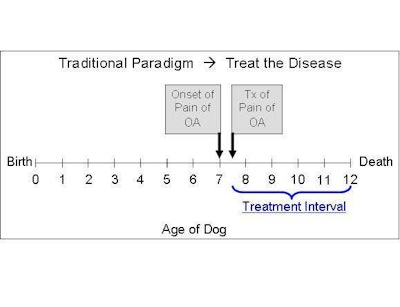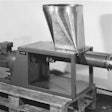
Predictive Medicine
Challenges and Opportunities for the
Pet Food Industry
What is "Predictive Medicine?" Predictive Medicine is a modern medical paradigm incorporating "disease risk assessment" followed by treatments/strategies to offset that estimated "risk." The "genomic era" has ushered in the hope of unraveling the genetic basis of disease. However, the associations between the genes and the ultimate manifestation of many of the most common diseases (for example cancer, diabetes, or hip dysplasia) are complex; meaning not simply the result of single-gene effects. It will likely be decades, if ever, before all the genes and all gene interactions for a particular complex disease are discovered. Yet, almost daily new gene-disease associations are being discovered. These discoveries, while not permitting an absolute knowledge of when or even whether a patient will succumb to a disease, nevertheless enable an estimation of a patient's risk or susceptibility for the disease. Based on this estimated risk, physicians and veterinarians can implement evidence-based "preventive" strategies to offset that risk.
The predictive test need not be a DNA test. It can be any
test; radiographic, MRI, ultrasound, CT, blood test, among
others, that can be shown to key on factors correlating with
the risk or susceptibility for a specific disease. The
logic is the same irrespective of mode of testing: knowing the
risk, one can implement measures early to offset that
risk. In this context, canine hip dysplasia and a hip
screening test known as PennHIP serve as an excellent
example.
Canine Hip Dysplasia (CHD) is an extremely common genetic
disease affecting most breeds of dogs, but particularly
large-breed dogs. It affects millions of dogs and leads
to osteoarthritis (OA) of the hip causing pain and decreased
performance for both pet dogs and for dogs in sport and
work. Treating the OA of hip dysplasia is big
business. The pharmaceutical industry manufactures
several NSAIDs (nonsteroidal anti-inflammatory drugs) to treat
the pain of OA and many of the leading pet food companies offer
premium, prescription diets having additives (eg.
nuetraceuticals) aimed at relieving joint discomfort and
slowing the rate of cartilage degradation in osteoarthritic
joints. The "traditional paradigm" for treating hip OA is
shown in the Illustration 1. The "treatment interval" for
administering the medication or ration begins shortly after the
onset of the pain and disability of OA and continues as
indicated for the life of the dog. In one study of 48
Labrador retrievers kept in a kennel setting, hip pain was not
evident and therefore pain medications were not administered
until affected dogs were 7 years of age or older, hence the
onset of the treatment interval in Illustration 1 at 7 years of
age.4
But Predicitve Medicine is the new paradigm. As mentioned
previously CHD is a disease of complex inheritance meaning that
its expression is influenced by both genetic and environmental
factors. A landmark study of diet restriction in
Labrador Retrievers demonstrated the profound influence of
calorie restriction (an environmental factor) on delaying the
onset of OA and lessening its severity.1-5 This study
proved definitively that a genetic disease could be mitigated
by appropriate environmental manipulation. Surely other
forms of environmental manipulation will be discovered to act
similarly to offset the risk of OA. Candidate strategies
include physical therapy, appropriate exercise regimen,
pharmaceuticals, neutraceuticals, and nutrigenomics however, to
date there are few studies to document the efficacy of these
strategies. Preliminary evidence, however, is
encouraging.
The concept of "risk reduction" requires a valid test of
disease risk. The PennHIP radiographic test was
developed at the University of Pennsylvania in 1983 and a large
body of research has been published to validate the test in its
ability to determine the "risk" for osteoarthritis at an age as
young as 16 weeks.6-27 It is the only test capable of
estimating the risk for hip OA. In the lifespan study
mentioned above, the PennHIP test of Labs at 2 years of age
indicated all dogs to be "at risk" for OA. By the end of
the dogs' natural lives 98% had definitive evidence of hip OA
(98% positive predictive value). From another study of an
entirely different sample of dogs, Illustration 2 is a plot of
OA risk for 4 breeds of dogs (mean age 39 months) relative to
PennHIP score (0.0-1.1). All 4 breeds of dogs
demonstrated a similar pattern of with respect to OA
risk: Radiographic OA risk was found to increase as
PennHIP score (DI) increased. From earlier research, it
was found that this risk for OA could be estimated as young as
16 weeks of age.
The dogs shown in illustration 2 were from the general pet
population and no strategies for risk reduction were attempted,
however, if diet restriction were imposed on these dogs early
in life (say 16 weeks) the evidence in the literature suggests
that the OA probability curves would flatten out. That is,
fewer dogs at the mean age of 39 months would have expressed
radiographic evidence of OA. The PennHIP method, therefore is a
powerful tool in determining which dogs are at risk for OA and
which dogs could benefit from preventive measures.
The rationale of implementing the "Predictive Medicine"
paradigm is shown in Illustration 3. With the knowledge
that a dog is at risk for a disease such as OA, one is
justified to implement strategies to offset the risk. The
net effect to the Pet Food Industry is to lengthen considerably
the "treatment interval". The advantages to the dog and
the dog owner are obvious: later onset of OA and reduced
severity of the disease, a better quality of life.
In conclusion, Predictive Medicine is here now. The
veterinarian can assess the risk of hip OA using the PennHIP
method and based on this information can prescribe treatments
as simple as diet restriction to lower significantly the risk
of expressing hip OA.















